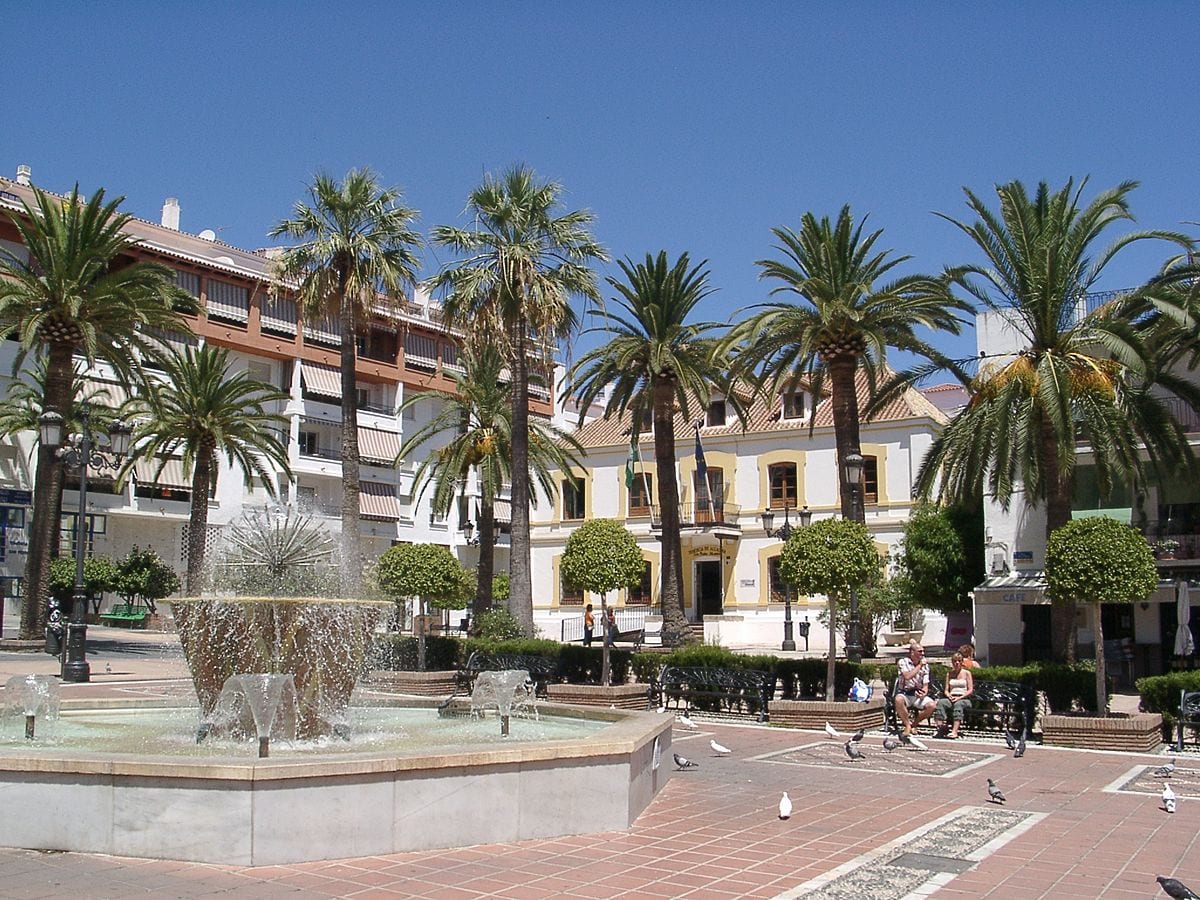It is 200 years since San Pedro Alcantara became one of Spain’s key agricultural colonies… and 2000 since the Romans enjoyed their time here, writes Jon Clarke
IT was during heavy storms in November 2021 when a ravaging high tide uncovered what could prove to be one of the most exciting discoveries on the Costa del Sol this century.
After a long night of howling winds and waves crashing down on the wilder, western extremes of San Pedro Alcantara beach, locals woke up to find a series of what looked like a collection of brick ovens, exposed by a landslide.
When it emerged they were apparently Roman and probably led to a much larger complex, the authorities quickly stepped in and did what any responsible archaeologist would do; took some photos and measurements and quickly covered them up again in sand.
I had been one of the fortunate locals to stroll past that morning and got a good look at the treasure that had emerged overnight. Alongside a friendly local historian, who curates visits to the nearby Roman baths and neighbouring sixth century Paleochristian church, we marvelled at the extent of the complex.

Right next to the ancient Roman road from Cadiz to Cartagena, in Murcia, (the one that also goes past the Roman bridge at the Puente Romano hotel and the Villa Romano at Rio Verde in Banus) it seemed obvious to him that this was a key industrial complex and all three sites were once linked. We speculated a garum fish paste, or even a brick factory and he said he hoped an archaeological dig would launch some time next year to investigate further. But in Andalucia, that might be in 2030.
It is sometimes easy to forget about the incredible rich history that surrounds those of us fortunate to live around Marbella and its sister resort San Pedro Alcantara. Particularly after a busy summer season.
Fortunately in San Pedro you’ve got reminders all around you, if you know where to look.
To get a really good idea of what makes San Pedro tick, start by walking the entire length of the town’s new, hypermodern boulevard, with its spaceage flyerovers, skate parks and fountains.
At both ends remnants of this once important agricultural centre are still firmly anchored.

At the Trapiche de Guadaiza sugar mill and around the atmospheric hamlet of El Ingenio, with its now-protected working men’s cottages and adjoining mill/distillery, you find yourself transported back to the early 19th century, when the area comprised Spain’s most modern, profitable agricultural community.
A conglomeration of estates pulled together by the grand Marques del Duero and his, even grander, wife Francisca de Paula Tovar y Puguera Amat de La Gasca, aka the Marquess of Revilla, its 5000 hectares were almost all planted with sugar cane. A highly profitable crop at the beginning of the 19th century, there were nearly two dozen sugar mills (‘trapiches’) on the coast and no less than two either end of San Pedro.
While large swathes of the coast were covered in cane (and the famous Larios gin family owned much of it), it was San Pedro that got the headlines nationally.
Importing the most modern machinery from France and Britain, the landowners also broke from the mould by building colonies for their workers, hamlets made up of small, but well built cottages, that would guarantee a modicum of comfort.
Workers soon arrived from as far and wide as Valencia, Murcia and Almeria, as they heard of the success of the groundbreaking new crop and irrigation systems.

The Agricultural Colony of San Pedro Alcantara was officially opened in 1860 and became the ‘most important in Spain’, creating thousands of jobs and leading to a key nucleus on the Costa del Sol. When sugar cane stopped being profitable by the late 1880s, the colony diversified into other produce, including beetroot, cereals, citrus fruit and even cotton. And after things were brought to a grinding halt by the civil war, they soon found themselves a new industry: tourism!
Today, the only cotton you will find is in the various fashion shops scattered around the bustling town centre, with one, a Norwegian owned boutique in the Ingenio area.
While not quite up to the high fashion levels of nearby Marbella, there are loads of interesting boutiques dotted around, as well as a mixture of book shops (two English ones alone), half a dozen bike shops, and hundreds of others selling fruit, ice cream or restaurants and tapas bars.
“Everything is so close and it has still got its village feel,” explains local estate agent Ana Troyano, whose family have run a bakery and other businesses locally since the 1940s.
“You can find anything you need and both the beach and hills are within walking distance,” adds the owner of iHome, which has a bijoux office in the heart of the town.
“My mother was actually born in it and I hope the authorities can somehow maintain the close-knit old village feel you still get here.”
There is certainly a very local feel to the centre, which is crammed with narrow streets of whitewashed houses interspersed with dozens of shady plazas.
It’s not grand and ornate like other more celebrated Andalucian towns, but the attractive Plaza de la Iglesia is well worth a visit and home to the impressive 19th century Iglesia de San Pedro.
Surrounded with statues, benches and water features; and a myriad of bars and restaurants with outdoor terraces, it is usually a lively place.

Behind the church on a roundabout look out for the statue of the Marques del Duero, Don Manuel Gutierrez de la Concha, the former army general standing guard over his 5000 hectares, which extended as far as Benahavis, Cancelada and Estepona.
From here take a walk downhill towards the continually evolving Bulevar de San Pedro, best known for its undulating pedestrian bridge that snakes high above it like a fairground ride.
Something of a tourist attraction, this head-turning ironwork addition to the main drag sits beside a giant play park, an ice rink (for winter) and a superb skate park, down by the Trapiche.
Whether you love this impressive feat of engineering or regard its design as a bridge too far, it is hugely symbolic. For this gyrating overpass and shiny boulevard is a bold statement of how the town has progressed since a decade ago, when it was split in two by the main coastal motorway and awash with traffic and all the fumes and noise this inevitably brought.
Today, this unpretentious coastal resort, wedged between Estepona and Marbella and hugged by two mountain ranges, has come of age with a long tunnel under its feet.
Just ask any of the Spanish families or couples taking an evening stroll down the boulevard, perhaps after they have stopped to watch a show in summer at the amphitheatre, or sat down at one of the handful of cafes for an evening cana and tapas.
They’ll tell you how the €85 million tunnel has totally revolutionised their town, how the new green spaces are a joy to run around, and how there’s a new school, new sports centres and a new underground car park. Next they’re expecting a big commercial centre on the outskirts of town, plus possibly a new theatre, even a university.

Head another half mile south and you’ll find the San Pedro promenade. A once scruffy zone that has been much spruced up over recent years, with hundreds of palm trees and a dozen chiringuitos.
While the beach always needs a fair bit of TLC after the winter storms it is starting to get noticed. There are football and volleyball clubs setting up, a beach gym and at least half a dozen yoga, crossfit and zumba classes on the grass every day through most of the year.
Nowadays you can walk – or cycle – all the way to Puerto Banus (even Marbella) and this is one busy passtime from 9am when the whole world seems to be out taking their morning constitutional.
Heading west, you must look out for the fragments of the town’s history. Hidden a few hundred metres behind a row of fishing boats and shacks, and towered over by a giant eucalyptus plantation are the ruins of the sixth century ‘early-Christian’ basilica Vega del Mar.
First excavated a century ago, the ruins were discovered by a farmer planting trees, and they offer up an atmospheric alternative view of the town. Open most mornings, you can also book a visit through the tourist office.
A bit further west, crossing the stream beside Macaao Beach Club, you’ll come to the most remarkable Roman bathhouse, known as Las Bovedas, standing next to one of the ancient watchtowers built in the 17th or 18th centuries to warn of approaching pirates.
While now technically in Guadalmina, if it happens to be open to the public, this is one wonderful construction to take a poke around and was once clearly linked to the basilica.

INDY SPIRIT
THE local Sanpedreños have a strong sense of their own identity.
Distinctly independent of their bigger sister Marbella, the town has a much more Spanish feel and is certainly far rougher around the edges, less polished, more real.
While they are administered by Marbella, they have their own town hall and have a reasonable say over planning rules.
That said, they have long called for their own municipality, as yet to no avail, but one local political party, the OSP, is firmly rooted in this demand.
FINAL HURRAH
OCTOBER’S San Pedro feria brings down the curtain on the Costa del Sol’s party season.
It’s the last town on the coast to pay homage to its patron saint in a seven-month season of ferias.
With bumper cars, pop-up bars and a ferris wheel, it is a feast of family fun.
Throughout Saturday and Sunday afternoon, expect to see women of all ages and shapes parade around the streets in slinky Sevillana dresses, while the menfolk also dress to the nines.
There’ll be plenty of traditional horse drawn carriages and flamenco dancing.
After a week of revelry, a mass exodus of Sanpedreños make their way down to the town’s outskirts for one last hurrah on Sunday night.

DID YOU KNOW?
San Pedro Alcantara takes its name from its founder, general Marques de Duero’s devotion to the patron saint of Extremadura, as well as honouring his mother, Lady Petra de Alcantara Irigoyen.
There has also been much debate about whether the correct name is San Pedro Alcantara or San Pedro de Alcantara… and incredibly Google Maps and the majority of road signs for the town – even on the A7 motorway through it – still use the latter.
The facts are it has been known as San Pedro Alcantara since its first census in 1860 and Malaga’s official property register reflected the name as such in 1870.
The confusion comes because the town’s patron saint is ‘San Pedro de Alcantara’ or ‘Saint Peter of Alcantara’, a town in the region of Extremadura.
The local mayor in 2009, Miguel Troyano, brought the issue up at a Marbella town hall meeting in October that year, insisting that from then on ALL official documents must reflect the correct name.
The motion was passed unanimously, with the records also stating that the town had its own distinct crest (that of its founder, the Marques del Duero).
READ MORE:
- 2 bedroom Apartment for sale in San Pedro de Alcantara with pool – € 265,000
- The 8 best Spanish restaurants to visit in Marbella’s San Pedro de Alcantara in 2020
- Where to eat in San Pedro de Alcantara
Click here to read more News from The Olive Press.








